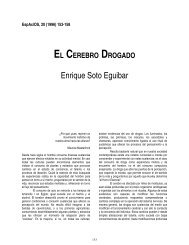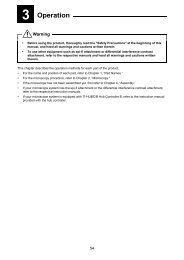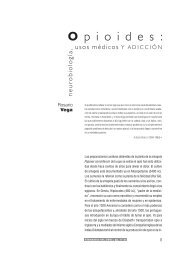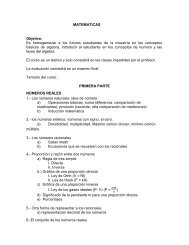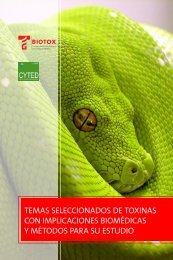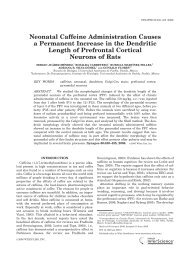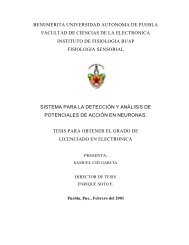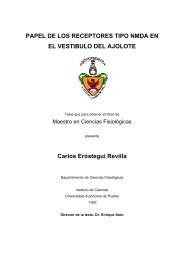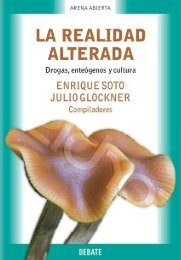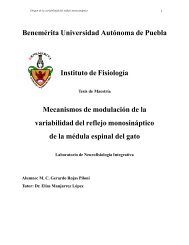D1 Dopamine Receptor Activation Reduces GABAA Receptor ...
D1 Dopamine Receptor Activation Reduces GABAA Receptor ...
D1 Dopamine Receptor Activation Reduces GABAA Receptor ...
You also want an ePaper? Increase the reach of your titles
YUMPU automatically turns print PDFs into web optimized ePapers that Google loves.
D 1 <strong>Dopamine</strong> <strong>Receptor</strong> <strong>Activation</strong> <strong>Reduces</strong> GABA A <strong>Receptor</strong><br />
Currents in Neostriatal Neurons Through a PKA/DARPP-32/PP1<br />
Signaling Cascade<br />
JORGE FLORES-HERNANDEZ, 1 SALVADOR HERNANDEZ, 1 GRETCHEN L. SNYDER, 2 ZHEN YAN, 2<br />
ALLEN A. FIENBERG, 2 STEPHEN J. MOSS, 3 PAUL GREENGARD 2 , AND D. JAMES SURMEIER 1<br />
1 Department of Physiology and Institute for Neuroscience, Northwestern University Medical School, Chicago, Illinois 60611;<br />
2 Laboratory of Molecular and Cellular Neuroscience, Rockefeller University, New York City, New York 10021; and 3 Medical<br />
Research Council/Laboratory of Molecular Cell Biology and Department of Pharmacology, University College, London<br />
WC1E 6BT, United Kingdom<br />
Flores-Hernandez, Jorge, Salvador Hernandez, Gretchen L. Snyder,<br />
Zhen Yan, Allen A. Fienberg, Stephen J. Moss, Paul Greengard,<br />
and D. James Surmeier. D 1 dopamine receptor activation<br />
reduces GABA A receptor currents in neostriatal neurons through a<br />
PKA/DARPP-32/PP1 signaling cascade. J. Neurophysiol. 83:<br />
2996–3004, 2000. <strong>Dopamine</strong> is a critical determinant of neostriatal<br />
function, but its impact on intrastriatal GABAergic signaling is poorly<br />
understood. The role of D 1 dopamine receptors in the regulation of<br />
postsynaptic GABA A receptors was characterized using whole cell<br />
voltage-clamp recordings in acutely isolated, rat neostriatal medium<br />
spiny neurons. Exogenous application of GABA evoked a rapidly<br />
desensitizing current that was blocked by bicuculline. Application of<br />
the D 1 dopamine receptor agonist SKF 81297 reduced GABA-evoked<br />
currents in most medium spiny neurons. The D 1 dopamine receptor<br />
antagonist SCH 23390 blocked the effect of SKF 81297. Membranepermeant<br />
cAMP analogues mimicked the effect of D 1 dopamine<br />
receptor stimulation, whereas an inhibitor of protein kinase A (PKA;<br />
Rp-8-chloroadenosine 3,5 cyclic monophosphothioate) attenuated<br />
the response to D 1 dopamine receptor stimulation or cAMP analogues.<br />
Inhibitors of protein phosphatase 1/2A potentiated the modulation by<br />
cAMP analogues. Single-cell RT-PCR profiling revealed consistent<br />
expression of mRNA for the 1 subunit of the GABA A receptor—a<br />
known substrate of PKA—in medium spiny neurons. Immunoprecipitation<br />
assays of radiolabeled proteins revealed that D 1 dopamine<br />
receptor stimulation increased phosphorylation of GABA A receptor<br />
1/3 subunits. The D 1 dopamine receptor-induced phosphorylation<br />
of 1/3 subunits was attenuated significantly in neostriata from<br />
DARPP-32 mutants. Voltage-clamp recordings corroborated these<br />
results, revealing that the efficacy of the D 1 dopamine receptor modulation<br />
of GABA A currents was reduced in DARPP-32-deficient<br />
medium spiny neurons. These results argue that D 1 dopamine receptor<br />
stimulation in neostriatal medium spiny neurons reduces postsynaptic<br />
GABA A receptor currents by activating a PKA/DARPP-32/protein<br />
phosphatase 1 signaling cascade targeting GABA A receptor 1<br />
subunits.<br />
INTRODUCTION<br />
Disordered neostriatal dopaminergic signaling is a central<br />
determinant of a variety of psychomotor illnesses including<br />
Parkinson’s disease, schizophrenia, and drug abuse (Grace et<br />
The costs of publication of this article were defrayed in part by the payment<br />
of page charges. The article must therefore be hereby marked “advertisement”<br />
in accordance with 18 U.S.C. Section 1734 solely to indicate this fact.<br />
al. 1998; Hornykiewcz 1973; Koob et al. 1997; Wise 1998).<br />
Although dopamine is known to modulate voltage-dependent<br />
ion channels in neostriatal neurons (e.g., Surmeier et al. 1992,<br />
1995), its regulation of classical neurotransmission is less<br />
clearly defined (Calabresi et al. 1993; Cepeda et al. 1998; Kita<br />
et al. 1995; Mercuri et al. 1985; Nicola and Malenka 1998; Yan<br />
and Surmeier 1997). This is particularly true of GABAergic<br />
signaling. Inhibitory GABAergic synaptic input to neostriatal<br />
neurons is thought to be entirely of intrinsic origin, arising<br />
either from recurrent collaterals of GABAergic medium spiny<br />
projection neurons or from GABAergic interneurons (Kita<br />
1993; Wilson and Groves 1980). Only a handful of studies<br />
have attempted to determine how dopamine influences this<br />
intrastriatal GABAergic pathway. Most of those studies have<br />
focused on dopamine’s actions at D 1 dopamine receptors. For<br />
example, D 1 dopamine receptor stimulation increases GABA<br />
release (Harsing and Zigmond 1997). However, D 1 dopamine<br />
receptor agonists appear to be ineffective in modulating<br />
GABAergic synaptic potentials in dorsal neostriatal neurons, in<br />
spite of the fact that they inhibit GABAergic signaling in the<br />
nucleus accumbens (Nicola and Malenka 1998; cf. Calabresi et<br />
al. 1993).<br />
At face value, the inability of D 1 dopamine receptor agonists<br />
to modulate GABAergic synaptic potentials in medium spiny<br />
neurons is surprising. D 1 dopamine receptors are expressed by<br />
the majority of medium spiny neurons (Gerfen 1992; Surmeier<br />
et al. 1996). These receptors positively couple to adenylyl<br />
cyclase, resulting in the stimulation of protein kinase A (PKA)<br />
(Stoof and Kebabian 1984; Walaas and Greengard 1991). PKA<br />
has been shown to modulate GABA A receptor-mediated currents<br />
in both heterologous and native expression systems<br />
(Smart 1997).<br />
The preferred substrate for PKA in the GABA A receptor<br />
oligomer is the subunit. But of the three cloned subunits<br />
found in neurons (1–3), only 1 and 3 are efficiently phosphorylated<br />
by PKA (McDonald et al. 1998). Moreover, the<br />
functional consequences of 1 and 3 subunit phosphorylation<br />
are qualitatively different. In heterologous systems, phosphorylation<br />
of 1 subunits results in diminished GABA A receptor<br />
currents, whereas phosphorylation of 3 subunits leads to<br />
increased currents (McDonald et al. 1998). This suggests that<br />
by controlling the expression of subunits, their assembly into<br />
2996 0022-3077/00 $5.00 Copyright © 2000 The American Physiological Society
D 1 MODULATION OF GABA A RECEPTORS<br />
2997<br />
functional receptors or their accessibility, neurons can regulate<br />
the consequences of PKA activation. An example of how this<br />
type of regulation might work has been reported in the hippocampus<br />
where PKA diminished GABAergic miniature inhibitory<br />
postsynaptic currents (mIPSCs) in CA1 pyramidal<br />
neurons that express 1 subunits, whereas PKA had no effect<br />
on mIPSCs in granule cells that express primarily 2 subunits<br />
(Poisbeau et al. 1999). Although it is clear that medium spiny<br />
neurons express GABA A receptors, the contribution of 1, 2,<br />
and 3 subunits to these channels has not been studied.<br />
To provide a more thorough examination of their regulation<br />
by D 1 dopamine receptors, GABA A receptors in acutely isolated,<br />
voltage-clamped medium spiny neurons were stimulated<br />
with exogenous GABA. These experiments revealed a consistent<br />
decrement in GABA-evoked currents after D 1 dopamine<br />
receptor stimulation. These observations then were pursued<br />
with a combination of molecular, biochemical, and electrophysiological<br />
techniques to determine the signaling pathway<br />
linking D 1 dopamine receptors to GABA A receptors.<br />
METHODS<br />
Electrophysiological methods<br />
ACUTE-DISSOCIATION PROCEDURE. Neostriatal neurons from adult<br />
(4 wk) rats were acutely dissociated using procedures similar to<br />
those previously described (Song et al. 1998; Surmeier et al. 1996;<br />
Yan and Surmeier 1997). In brief, rats were anesthetized with methoxyflurane<br />
and decapitated; brains were removed quickly, iced, and<br />
then blocked for slicing. The blocked tissue was cut into 400-m<br />
slices with a Vibroslice (Campden Instruments, London) while bathed<br />
in a low-Ca 2 (100 M), N-[2-hydroxyethyl]piperazine-N-[2-ethanesulfonic<br />
acid] (HEPES)-buffered salt solution [containing (in mM)<br />
140 Na isethionate, 2 KCl, 4 MgCl 2 , 0.1 CaCl 2 , 23 glucose, and 15<br />
HEPES, pH 7.4, 300–305 mosm/l]. Slices then were incubated for<br />
1–6 h at room temperature (20–22°C) in a NaHCO 3 -buffered saline<br />
bubbled with 95% O 2 -5% CO 2 [which contained (in mM) 126 NaCl,<br />
2.5 KCl, 2 CaCl 2 , 2 MgCl 2 , 26 NaHCO 3 , 1.25 NaH 2 PO 4 ,1 pyruvic<br />
acid, 0.2 ascorbic acid, 0.1 N G -nitro-L-arginine, 1 kynurenic acid, and<br />
10 glucose, pH 7.4 with NaOH, 300–305 mosm/l]. All reagents<br />
were obtained from Sigma Chemical (St. Louis, MO). Slices then<br />
were transferred into the low-Ca 2 buffer and regions of the dorsal<br />
neostriatum dissected and placed in an oxygenated Cell-Stir chamber<br />
(Wheaton, Millville, NJ) containing pronase (Sigma protease Type<br />
XIV, 1–3 mg/ml) in HEPES-buffered Hank’s balanced salt solution<br />
(HBSS, Sigma Chemical) at 35°C. Dissections were limited to tissue<br />
rostral to the anterior commissure. After 20–40 min of enzyme<br />
digestion, tissue was rinsed three times in the low-Ca 2 , HEPESbuffered<br />
saline and mechanically dissociated with a graded series of<br />
fire-polished Pasteur pipettes. The cell suspension then was plated into<br />
a 35-mm Lux petri dish mounted on the stage of an inverted microscope<br />
containing HEPES-buffered HBSS saline.<br />
In some experiments, cultured neostriatal neurons were used. Cultures<br />
were generated as previously described from E18 Sprague-<br />
Dawley rat pups (Surmeier et al. 1988). After 3 days in vitro, cultures<br />
were transferred to defined media consisting of Neurobasal media<br />
supplemented with B-27, Pen/Strep, L-glutamine (0.5 mM; Life Technologies),<br />
brain derived neurotrophic factor (BDNF, 50 nM; Promega),<br />
and glial derived neurotrophic factor (GDNF, 30 nM; Promega).<br />
The media was partially replaced (50%) every 4 days<br />
thereafter. Cultures were used for recording 10–14 days after plating.<br />
WHOLE CELL RECORDINGS. Recordings of GABA-activated currents<br />
employed standard techniques (Yan and Surmeier 1997). Electrodes<br />
were pulled from Corning 7052 glass and fire-polished before<br />
use. For acutely isolated neurons, the internal solution consisted of (in<br />
mM) 180 N-methyl-D-glucamine (NMG), 40 HEPES, 4 MgCl 2 , 5 1,2<br />
bis-(o-aminophenoxy)-ethane-N,N,N,N-tetraacetic acid (BAPTA),<br />
12 phosphocreatine, 2 Na 2 ATP, 0.2 Na 3 GTP, and 0.1 leupeptin, pH <br />
7.2–3 with H 2 SO 4 , 265–270 mosm/l. The external solution consisted<br />
of (in mM) 135 NaCl, 20 CsCl, 1 MgCl 2 , 10 HEPES, 0.001 TTX, 0.5<br />
BaCl 2 , and 10 glucose, pH 7.3 with NaOH, 300–305 mosm/l. For<br />
cultured neurons, the internal solution consisted of (in mM) 30 CsCl,<br />
80 K 2 SO 4 , 10 HEPES, 6 MgCl 2 , 3.5 BAPTA, 12 phosphocreatine, 2<br />
Na 2 ATP, 0.2 Na 3 GTP, and 0.1 leupeptin, pH 7.2–3 with H 2 SO 4 ,<br />
265–270 mosm/l. The external solution consisted of (in mM) 140<br />
NaCl, 2.8 KCl, 1 MgCl 2 , 10 HEPES, 0.001 TTX, 0.5 CaCl 2 , and 10<br />
glucose, pH 7.3 with NaOH, 300–305 mosm/l.<br />
Recordings were obtained with an Axon Instruments 200 patchclamp<br />
amplifier that was controlled and monitored with a PC 486<br />
clone running pCLAMP (v. 6.0) with a DigiData 1200 series interface<br />
(Axon Instruments, Foster City, CA). Electrode resistances were<br />
typically 2–4 M in the bath. After seal rupture, series resistance<br />
(4–10 M) was compensated (70–90%) and periodically monitored.<br />
Drugs were applied with a gravity-fed “sewer pipe” system. The array<br />
of application capillaries (ca. 150 m ID) was positioned a few<br />
hundred micrometers from the cell under study. Solution changes<br />
were made by altering the position of the array with a microprocessorcontrolled<br />
DC drive system (Newport-Klinger, Irvine, CA). Solution<br />
changes were complete within 1 s. The membrane potential was<br />
held at 0 mV in recordings from acutely isolated neurons; the membrane<br />
potential was held at 80 mV in recordings from cultured<br />
neurons. GABA (0.1–2,000 M) was applied briefly (3–5 s) every<br />
minute<br />
<strong>Dopamine</strong> receptor ligands—dopamine, SKF-81297 and R()-<br />
SCH-23390 (RBI, Natick, MA)—were made up as concentrated<br />
stocks in deoxygenated water containing 0.1% sodium metabisulfite.<br />
Solutions were protected from ambient light. Second-messenger reagents<br />
Sp-8-chloroadenosine 3:5-cyclic monophosphothioate (Sp-<br />
Cl-cAMPS), Rp-8-chloroadenosine 3,5 cyclic monophosphothioate<br />
(Rp-Cl-cAMPS), 3,6 dichloro-1-b-D-ribofuranosylbenzimidazole<br />
3,5 cyclic monophosphothioate (Sp-5,6-DCl-cBIMPS), 8-(4-chlorophenylthio)<br />
guanosine-3,5 monophosphate (8-pCPT-cGMP) (Biolog<br />
Life Sciences, La Jolla, CA) were made up as concentrated stocks in<br />
water or dimethyl sulfoxide and stored at 70°C. Stocks were thawed<br />
and diluted immediately before use.<br />
STATISTICAL METHODS. Data analyses were performed with Axo-<br />
Graph (Axon Instruments, ver. 2.0) and SYSTAT (Chicago, IL). Box<br />
plots were used for graphic presentation of the data because of the<br />
small sample sizes (Tukey 1977). The box plot represents the distribution<br />
as a box with the median as a central line and the hinges as the<br />
edges of the box (the hinges divide the upper and lower halves of the<br />
distributions in half). The inner fences (shown as a line originating<br />
from the edges of the box) run to the limits of the distribution<br />
excluding outliers (defined as points that are 1.5 times the interquartile<br />
range beyond the interquartiles) (Tukey 1977); outliers are shown as<br />
asterisks or circles. Nonparametric statistical tests (Kruskal-Wallis<br />
ANOVA, Mann-Whitney U test) were used because of the small<br />
sample sizes and the uncertain sampling distributions.<br />
Single-neuron RNA harvest and RT-PCR analysis<br />
Methods similar to those previously described were used (Song et<br />
al. 1998; Tkatch et al. 1998; Yan and Surmeier 1997). Briefly, after<br />
recording, neostriatal neurons were lifted up into a stream of control<br />
solution and aspirated into the electrode by negative pressure. Electrodes<br />
contained 5 l of sterile recording solution (see preceding<br />
text). The capillary glass used for making electrodes had been autoclaved<br />
and heated to 150°C for 2 h. Sterile gloves were worn during<br />
the procedure to minimize RNase contamination. After aspiration, the<br />
electrode was broken and contents ejected into a 0.5-ml Eppendorf<br />
tube containing 5 l diethyl pyrocarbonate (DEPC)-treated water, 1
2998 FLORES-HERNANDEZ ET AL.<br />
l RNasin (28 U/l), 1 l dithiothreitol (DTT; 0.1 M), and 1 l of<br />
oligo(dT) (0.5 g/l) primer. The mixture was heated to 70°C for 10<br />
min and incubated on ice for 1 min. Single-strand cDNA was synthesized<br />
from the cellular mRNA by adding SuperScript II RT (1 l,<br />
200 U/l) and buffer (4 l, 5 first strand buffer: 250 mM Tris-HCl,<br />
375 mM KCl, 15 mM MgCl 2 ), DTT (1 l, 0.1 M) and mixed dNTPs<br />
(1 l, 10 mM). The mixture (20 l) was incubated for 50 min in a<br />
42°C water bath. The reaction was terminated by heating the mixture<br />
to 70°C for 15 min and then icing. The RNA strand in the RNA-DNA<br />
hybrid then was removed by adding 1 l RNase H (2 U/l), and the<br />
solution was incubated for 20 min at 37°C. All reagents except for<br />
RNasin (Promega, Madison, WI) were obtained from Life Technologies<br />
(Grand Island, NY). The cDNA from the reverse transcription<br />
(RT) of RNA in single neostriatal neurons was subjected to polymerase<br />
chain reactions (PCR) to detect the expression of various mRNAs.<br />
PCR amplification was carried out with a thermal cycler (MJ<br />
Research, Watertown, MA) with thin-walled plastic tubes. Conventional<br />
45-cycle PCR amplification was used for the detection of ChAT<br />
mRNA. Reaction mixtures contained 2–2.5 mM MgCl 2 , 0.5 mM of<br />
each of the dNTPs, 0.8–1 M primers, 2.5 U Taq DNA polymerase<br />
(Promega), 5 l 10 buffer (Promega), and 1–2 l cDNA template<br />
made from the single cell RT reaction (see preceding text). The<br />
thermal cycling program for these PCR amplifications was: 94°C for<br />
1 min, 58°C for 1 min, and 74°C for 1.5 min. To detect GABA A<br />
receptor subunit mRNAs (1–4, 1–3) in single cells, degenerate and<br />
“nested” primers were employed. In the first step, degenerate primers<br />
targeting the conserved regions of all the subunits were mixed with<br />
one-fourth of the single cell cDNA template and 30 rounds of amplification<br />
were performed. The same procedure was used to amplify <br />
subunit cDNA. In the second step, an aliquot (2 l) of diluted (1:10)<br />
first-round PCR product was used as the template for 40-cycle PCR<br />
with subunit-specific nested primers. These primers were positioned<br />
inside the region spanned by the degenerate primers. The primer sets<br />
used have been published previously (Surmeier et al. 1996; Yan and<br />
Surmeier 1997).<br />
Products were visualized by staining with ethidium bromide and<br />
analyzed by electrophoresis in 2% agarose gels. All products were<br />
sequenced using a dye termination procedure and found to match the<br />
published sequences. Care was taken to ensure that the PCR signal<br />
arose from cellular mRNA. In addition to the controls noted above<br />
(e.g., primers that span splice sites), negative controls for contamination<br />
from extraneous and genomic DNA were run for every batch of<br />
neurons. To ensure that genomic DNA did not contribute to the PCR<br />
products, neurons were aspirated and processed in the normal manner<br />
except that the reverse transcriptase was omitted. Contamination from<br />
extraneous sources was checked by replacing the cellular template<br />
with water. Both controls were consistently negative in these experiments.<br />
Preparation, radioactive labeling, and treatment of<br />
neostriatal slices<br />
Male C57BL/6 mice (8–12 wk of age) were killed by decapitation.<br />
The brain was removed rapidly from the skull and transferred to an<br />
ice-cold surface where it was blocked then mounted to the cutting<br />
surface of a Vibratome (TPI). Coronal sections (400 m) of the brain<br />
were cut and pooled in 10 ml of ice-cold, oxygenated calcium-free,<br />
phosphate-free Krebs bicarbonate buffer containing the following<br />
components (in mM): 125 NaCl, 4 KCl, 26 NaHCO 3, 1.5 MgSO 4 , 0.5<br />
EGTA, and 10 glucose (pH 7.4). Slices of neostriatum were dissected<br />
from these coronal sections under a dissecting microscope. The slices<br />
were pooled in a dish of cold buffer and transferred individually to<br />
4-ml polypropylene centrifuge tubes containing 2 ml of fresh buffer at<br />
4°C. The Krebs bicarbonate buffer then was replaced with fresh<br />
solution. The tubes were connected to an oxygenation manifold supplying<br />
a 95%O 2 -5%CO 2 mix and maintained in a 30°C water bath.<br />
After 15 min the buffer was replaced with a fresh phosphate-free,<br />
oxygenated Krebs bicarbonate buffer containing 1.5 mM CaCl 2 and<br />
lacking EGTA. A 2.0-mCi aliquot of [ 32 P]orthophosphoric acid (Du-<br />
Pont NEN; specific activity 8,500–9,120 Ci/mmol) was added to each<br />
tube, and the tissue was preincubated for 60 min. The radioactive<br />
buffer then was removed, and tissue sections were rinsed twice with<br />
2 ml of fresh buffer. The tissue was incubated in the absence or<br />
presence of test substances, as indicated. At the end of the incubation,<br />
the buffer was rapidly aspirated, and the tissue slices were immediately<br />
frozen in liquid nitrogen and stored at 80°C until assayed.<br />
Immunoprecipitation and analysis of [ 32 P]phosphate-labeled<br />
GABA A receptor subunit<br />
[ 32 P]phosphate-labeled tissue slices were sonicated in 150 lof1%<br />
sodium dodecyl sulfate (SDS) containing NaF (50 mM) and 1 mM<br />
EGTA added as phosphatase inhibitors, and a cocktail of protease<br />
inhibitors, including 25 mM benzamidine, 100 M phenylmethylsulfoxide,<br />
20 g/ml chymostatin, 20 g/ml pepstatin A, 5 g/ml leupeptin,<br />
and 5 g/ml antipain (Peptide International). To this homogenate<br />
were added 5 volumes of Buffer A, composed of 20 mM<br />
Tris/HCl (pH 8.0), 150 mM NaCl, 5 mM EDTA, 1% Triton X-100,<br />
0.2% bovine serum albumen (BSA) and the cocktail of phosphatase<br />
and protease inhibitors described above. Aliquots of the homogenate<br />
(10 l) were retained for the determination of total [ 32 P]phosphate<br />
incorporation into trichloroacetic acid-precipitated protein. A 10 mg<br />
aliquot of preswollen Protein A-Sepharose CL-4B (Pharmacia Biotech)<br />
was added to each sample and the mixture agitated for 30 min<br />
at 4°C. The Sepharose beads were pelleted by centrifugation for 15 s<br />
at 2,000 rpm in a tabletop microcentrifuge. The supernatant was<br />
transferred to tubes containing 2.5 g of an antiserum generated<br />
against a peptide sequence contained in both the 1 and 3 subunits<br />
of the GABA A receptor. The samples were mixed for 2hat4°C, then<br />
transferred to fresh 1.5-ml Eppendorf tubes containing 10 mg preswollen<br />
Protein A-Sepharose Cl-4B beads and mixed for 1hat4°C.<br />
The beads were pelleted by centrifugation and washed once with 1 ml<br />
of Buffer A; three times with 1 ml of a buffer containing 20 mM<br />
Tris/HCl, pH 8.0, 150 mM NaCl, 5 mM EDTA, 0.5% Triton X-100,<br />
0.1% SDS, and 0.2% BSA; three times with a buffer containing 20<br />
mM Tris/HCl, pH 8.0, 500 mM NaCl, 0.5% Triton X-100, and 0.2%<br />
BSA; and once with 1 ml of a buffer containing 50 mM Tris/HCl, pH<br />
8.0. After the final wash the beads were resuspended in 50 l ofa<br />
SDS-polyacrylamide gel electrophoresis (SDS-PAGE) sample buffer<br />
composed of 50 mM Tris/HCl (pH 6.7), 10% glycerol, 2% SDS, 10%<br />
2-mercaptoethanol, and 0.01% bromphenol blue. The tubes were<br />
vortexed vigorously and the beads were centrifuged. The recovered<br />
proteins were separated on 10% acrylamide gels. The gels were dried,<br />
and [ 32 P]phosphate incorporation was quantified using a PhosphorImager<br />
400B and ImageQuant software from Molecular Dynamics.<br />
Values for [ 32 P]phosphate content were normalized for the total<br />
[ 32 P]phosphate incorporated into TCA-precipitable protein.<br />
RESULTS<br />
D 1 dopamine receptor stimulation reduces GABA-evoked<br />
currents<br />
The application of GABA (100 M) evoked a rapidly desensitizing<br />
current in medium spiny neurons voltage clamped<br />
at 0 mV. The current was blocked by bicuculline (100 M) and<br />
reversed near the Cl reversal potential (data not shown),<br />
implicating GABA A receptors. As shown in Fig. 1A, the D 1<br />
dopamine receptor agonist SKF 81297 (1 M) reversibly decreased<br />
GABA-evoked currents in the majority of medium<br />
spiny neurons (20/28) initially sampled (n 20, P 0.05,<br />
Kruskal-Wallis ANOVA). On average, peak whole cell currents<br />
evoked by GABA (100 M) were reduced by 18% by
D 1 MODULATION OF GABA A RECEPTORS<br />
2999<br />
cyclase, exogenous application of membrane permeant cAMP<br />
analogues should mimic the receptor-driven modulation. To<br />
test this hypothesis, Sp-Cl-cAMPS (100 nM) was perfused<br />
during whole cell recording. As shown in Fig. 2A, Sp-ClcAMPS<br />
decreased GABA-evoked currents in a manner similar<br />
to the D 1 dopamine receptor agonist (n 12, P 0.05,<br />
Kruskal-Wallis ANOVA). The median decrease in peak<br />
evoked current was similar (22%) to that of SKF 81297 (Fig.<br />
2B). The membrane permeant cGMP analogue 8-pCPT-cGMP<br />
(100 M) had no effect on GABA-evoked currents, arguing<br />
that the modulation was PKA specific (n 7, P 0.05,<br />
Kruskal-Wallis ANOVA).<br />
FIG. 1. D 1 dopamine receptor agonists reduce GABA-evoked currents. A:<br />
whole cell voltage-clamp recordings from an acutely isolated medium spiny<br />
neuron showing currents evoked by GABA (100 M) application in the<br />
absence (control) and presence of SKF 81297 (1 M). Response was reversed<br />
on washing off the D 1 dopamine receptor agonist. Right: box plot summarizing<br />
the reduction in peak GABA-evoked currents produced by SKF 81297 (n <br />
21). As shown, the coapplication of the D 1 dopamine receptor antagonist SCH<br />
23390 (1 M) with SKF 81297 significantly attenuated the modulation (n 9,<br />
P 0.05, Kruskal-Wallis ANOVA). B: application of SKF 81297 also<br />
reversibly decreased inward GABA-evoked currents in cultured striatal neurons.<br />
SKF 81297 (0.1–1 M). The kinetics of the evoked currents<br />
were not noticeably altered by D 1 dopamine receptor agonists.<br />
Coapplication of the D 1 dopamine receptor antagonist SCH<br />
23390 (1 M) blocked the reduction in evoked currents produced<br />
by SKF 81297 (n 9, P 0.05, Kruskal-Wallis<br />
ANOVA; Fig. 1A). To verify that the D 1 receptor-mediated<br />
modulation was not a consequence of dissociation, cultured<br />
neostriatal neurons also were studied. In these recordings, the<br />
Cl reversal potential was near 0 mV, and the cell was held at<br />
80 mV. As shown in Fig. 1B, the D 1 receptor agonist SKF<br />
81297 (1 M) also reversibly reduced the inward currents<br />
evoked by GABA (100 M) in these neurons. More than<br />
one-half of the cultured neurons responded to SKF 81297<br />
(11/17). In the responsive subset, SKF 81297 reduced the<br />
bicuculline-sensitive GABA-evoked currents by an average of<br />
22 4% (mean SD).<br />
<strong>Activation</strong> of D 1 dopamine receptors in medium spiny neurons<br />
leads to the stimulation of adenylyl cyclase and the<br />
elevation of cytosolic cyclic AMP (cAMP) (Stoof and Kebabian<br />
1984). If the modulation of GABA A receptors by D 1<br />
dopamine receptors was mediated by stimulation of adenylyl<br />
FIG. 2. cAMP analogues mimic the D 1 dopamine receptor modulation of<br />
GABA-evoked currents and protein phosphatase 1/protein phosphatase 2A<br />
(PP1/PP2A) inhibition enhances the modulation. A: whole cell voltage-clamp<br />
recordings from an acutely isolated medium spiny neuron showing currents<br />
evoked by GABA (100 M) application in the absence (control) and presence<br />
of the protein kinase A (PKA) agonist Sp-8-chloroadenosine 3:5-cyclic<br />
monophosphothioate (Sp-Cl-cAMPS; 10 M). Response was reversed on<br />
washing. B: box plot summarizing the reduction in peak GABA-evoked<br />
currents produced by SKF 81297 (n 21), Sp-Cl-cAMPS (n 12) and the<br />
PKG agonist 8-(4-chlorophenylthio) guanosine-3,5 monophosphate (8-<br />
pCPT-cGMP; n 7). Modulation was similar with the cAMP analogue and the<br />
receptor agonist but 8-pCPT-cGMP failed to significantly modulate the currents<br />
(P 0.05, Kruskal-Wallis ANOVA). C: whole cell voltage-clamp<br />
recordings from an acutely isolated medium spiny neuron showing currents<br />
evoked by GABA (100 M) application in the absence (control) and presence<br />
of 3,6 dichloro-1-b-D-ribofuranosylbenzimidazole 3,5 cyclic monophosphothioate<br />
(Sp-5,6-DCl-cBIMPS; 100 nM) alone and the PKA agonist Sp-5,6-<br />
DCl-cBIMPS (100 nM) plus calyculin A (100 nM). Response was reversed on<br />
washing. D: box plot summarizing the reduction in peak GABA-evoked<br />
currents produced by Sp-5,6-DCl-cBIMPS (n 5) and Sp-5,6-DCl-cBIMPS<br />
plus calyculin A (n 9). Modulation by Sp-5,6-DCl-cBIMPS in the presence<br />
of calyculin A was significantly larger than in the presence of Sp-5,6-DClcBIMPS<br />
alone (P 0.05, Kruskal-Wallis ANOVA).
3000 FLORES-HERNANDEZ ET AL.<br />
A major cellular target of cAMP is the regulatory subunit of<br />
PKA. To determine whether the cellular effects of the D 1<br />
agonist and cAMP analogues were mediated by PKA, the<br />
membrane permeant PKA inhibitor Rp-Cl-cAMPS was employed.<br />
Application of Rp-Cl-cAMPS (5 M) significantly<br />
reduced the response to SKF 81297 (median response 8%,<br />
n 4, P 0.05, Kruskal-Wallis ANOVA) and to Sp-ClcAMPS<br />
(median response 12%, n 4, P 0.05, Kruskal-<br />
Wallis ANOVA).<br />
To test for the involvement of protein phosphatase 1 (PP1)<br />
and protein phosphatase 2A (PP2A), the membrane permeant<br />
inhibitor calyculin A (100 nM) was applied. In the presence of<br />
the cAMP analogue Sp-5,6-DCl-cBIMPS (100 nM), calyculin<br />
A further reduced the GABA-evoked currents (Fig. 2C), increasing<br />
the median modulation to near 38% (n 4, P 0.05,<br />
Kruskal-Wallis ANOVA, Fig. 2D).<br />
Medium spiny neurons express 1 subunit mRNA<br />
n the GABA A receptor oligomer, the preferred targets of<br />
PKA are subunits. In heterologous systems, PKA has been<br />
shown to reduce GABA A receptor-mediated currents by phosphorylating<br />
a serine residue (S409) in the 1 subunit (Mc-<br />
Donald et al. 1998). On the other hand, phosphorylation of 3<br />
subunits by PKA increases GABA-evoked currents. 2 subunits<br />
do not appear to be regulated by PKA in situ (McDonald<br />
et al. 1998). In light of these findings, our results predict that<br />
medium spiny neurons that are responsive to D 1 dopamine<br />
receptor agonists should express 1 subunits. To test this<br />
hypothesis, single-cell RT-PCR experiments were performed<br />
(Yan and Surmeier 1997). Neurons expressing mRNA for the<br />
releasable peptide substance P (SP) previously have been<br />
shown to express D 1 dopamine receptor mRNA (Gerfen 1992;<br />
Surmeier et al. 1996). 1 mRNA was detected in all 11<br />
SP-expressing neurons tested. 3 mRNA was found in 7 of<br />
these 11. In contrast, 2 mRNA was not detected in medium<br />
spiny neurons. In Fig. 3A, the PCR amplicons from one of<br />
these neurons are shown.<br />
D 1 dopamine receptor stimulation increases phosphorylation<br />
of GABA A 1/3 subunits<br />
To determine whether PKA phosphorylated subunits in<br />
situ, immunoprecipitation experiments were performed. Neostriatal<br />
slices from C57BL/6 mice were preincubated with<br />
[ 32 P]orthophosphate, washed, and incubated with the adenylyl<br />
cyclase activator, forskolin (50 M). GABA A receptor subunits<br />
were immunoprecipitated using an antibody that recognized<br />
both the 1 and 3 subunits. Forskolin treatment increased<br />
the phosphorylation of a protein band of M r 55 kDa<br />
by 843 143% (n 5, P 0.05 vs. control, Mann-Whitney<br />
U test). This protein band was verified to be a subunit<br />
because its appearance was selectively blocked by preabsorption<br />
of the antibody with a fusion protein representing a sequence<br />
common to both 1 and 3 subunits (Fig. 3B). Incubation<br />
of neostriatal slices with the D 1 receptor agonist,<br />
SKF81297 increased receptor phosphorylation by 250% (Fig.<br />
3C).<br />
FIG. 3. Medium spiny neurons express GABA A receptor 1/3 subunits<br />
and D 1 dopamine receptor stimulation increases their phosphorylation. A, top:<br />
gel showing the scRT-PCR amplicons derived from a neuron expressing SP<br />
mRNA but not ENK mRNA. A, bottom: gel showing scRT-PCR GABA A<br />
receptor amplicons generated from the medium spiny neuron used in A. Note<br />
that both 1 and 3, but not 2, mRNA were detectable in this neuron. In a<br />
sample of 11 neurons, all 11 had detectable 1. Seven had detectable levels of<br />
3 mRNA, and none had detectable 2 mRNA. B: autoradiogram showing<br />
phosphorylation of GABA A receptor 1/3 subunits in mouse [ 32 P]-labeled<br />
neostriatal slices. Slices were incubated in the absence (control) or presence of<br />
forskolin (Fsk; 50 M, 5 min). Forskolin treatment increased the phosphorylation<br />
of a protein band associated with the 1/3 subunits of the GABA A<br />
receptor (4). Some forskolin-treated slices were immunoprecipitated with<br />
antiserum that had been preabsorbed with a GST-linked fusion protein representing<br />
sequences common to both the 1 and 3 subunits (1/3 fusion, 1<br />
g). Other forskolin-treated slices were immunoprecipitated with an unrelated<br />
hexahistidine fusion protein representing a region of the third transmembrane<br />
loop of the N-methyl-D-aspartate receptor subunit, NR1 (NR1 fusion, 1 g;<br />
provided by Drs. Lit-Fui Li and Richard L. Huganir, The Johns Hopkins<br />
University). C: treatment of prelabeled slices with the D 1 receptor agonist<br />
SKF81297 (1 M, 5 min) increased the phosphorylation of the receptor (1).<br />
In 4 experiments, summarized in the bottom panel, the phosphorylation state of<br />
subunits was increased 2- to 3-fold in response to treatment with SKF81297<br />
in wild-type neostriatal slices but not in those from DARPP-32 knockout mice<br />
(*P 0.05, compared with wild-type control, Mann-Whitney U test).<br />
Disruption of DARPP-32 diminishes the efficacy of D 1<br />
stimulation<br />
DARPP-32 is a key inhibitor of PP1 in medium spiny<br />
neurons that express D 1 dopamine receptors (Greengard et al.<br />
1999). Phosphorylation of DARPP-32 by PKA increases its<br />
inhibition of PP1 activity. Deletion mutations of DARPP-32<br />
have been shown to blunt PKA-mediated phosphorylation of
D 1 MODULATION OF GABA A RECEPTORS<br />
3001<br />
other cellular proteins (Fienberg et al. 1998). As shown in Fig.<br />
3, D 1 dopamine receptor agonists significantly increased radiolabeled<br />
phosphate incorporation into 1/3 subunits in slices<br />
from wild-type mice but failed to do so in DARPP-32 knockout<br />
mice.<br />
Functional assays then were performed to determine whether<br />
the DARPP-32 mutation altered the ability of D 1 agonists to<br />
modulate GABA-evoked currents. In wild-type mouse neostriatal<br />
neurons, as in the rat neurons described in the preceding<br />
text, SKF 81297 (1 M) decreased GABA A receptor-mediated<br />
currents. In neostriatal neurons from DARPP-32 knockout<br />
mice, 1 M SKF 81297 reduced currents by a similar amount.<br />
However, at lower concentrations of SKF 81297 (200 nM), the<br />
modulation of GABA-evoked currents was reduced dramatically<br />
in medium spiny neurons from DARPP-32 knockout<br />
mice compared with that seen in wild-type neurons (Fig. 4, A<br />
and B). A statistical summary of these experiments is shown in<br />
Fig. 4C. These results clearly indicate that DARPP-32 increases<br />
the efficacy of D 1 dopamine receptor stimulation in<br />
modulating GABA A receptors.<br />
DISCUSSION<br />
D 1 dopamine receptor activation triggers a PKA-dependent<br />
modulation of GABA A receptors<br />
FIG. 4. Disruption of DARPP-32 decreases the efficacy of the D 1 dopamine<br />
receptor modulation of GABA currents. A: in murine (as in rat) neostriatal<br />
medium spiny neurons, SKF 81297 produced a robust modulation of GABA A<br />
currents. B: in DARPP-32 mutant neurons, the modulation produced by 200<br />
nM SKF 81297 was significantly smaller than that produced in wild-type<br />
neurons at the same agonist concentration. C: statistical summary showing D 1<br />
dopamine receptor modulation (expressed as percent reduction in GABAevoked<br />
currents) in wild-type (n 7) and DARPP-32 mutant neurons (n 7)<br />
at 200 nM SKF 81297. Also shown are the responses to a high (1 M) agonist<br />
concentration in wild-type (n 2) and mutant neurons (n 4). Note that the<br />
lower SKF 81297 dose was saturating in wild-type neurons. However, in<br />
DARPP-32 mutants, this dose only evoked 25% of the maximal response seen<br />
in wild-type neurons (P 0.05, Kruskal-Wallis ANOVA).<br />
The data presented demonstrate that D 1 dopamine receptor<br />
stimulation reduces GABA A receptor-evoked currents in<br />
neostriatal medium spiny neurons. This reversible modulation<br />
was effectively antagonized by SCH 23390 at D 1 dopamine<br />
receptor-specific concentrations. As expected of a<br />
G s/olf -linked D 1 dopamine receptor signaling pathway (Stoof<br />
and Kebabian 1984), the modulation was mimicked by<br />
cAMP analogues. A primary cellular target of cAMP is the<br />
regulatory subunit of the PKA holoenzyme. An inhibitor of<br />
PKA (Rp-Cl-cAMPS) effectively reduced the consequences<br />
of receptor stimulation as well as bath application of cAMP<br />
analogues, implicating PKA-mediated protein phosphorylation<br />
in the modulation. The enhancement of the D 1 dopamine<br />
receptor-mediated modulation by inhibition of PP1/<br />
PP2A with calyculin A added strength to the inference that<br />
protein phosphorylation was involved. These observations<br />
are consistent with previous studies showing PKA-mediated<br />
reductions in recombinant and native GABA A receptor currents<br />
(Heuschneider and Schwartz 1989; Moss et al. 1992;<br />
Poisbeau et al. 1999; Porter et al. 1990; Schwartz et al.<br />
1991). As expected from recombinant studies showing that<br />
PKA phosphorylation of 1 subunits reduces evoked currents<br />
(McDonald et al. 1998), single-cell RT-PCR experiments<br />
revealed that essentially all medium spiny neurons<br />
expressed GABA A 1 subunit mRNA. Radiolabeling/immunoprecipitation<br />
studies confirmed that 1/3 subunit protein<br />
was phosphorylated in striatal neurons after D 1 dopamine<br />
receptor stimulation, suggesting that the 1 subunit was<br />
the obligate target of D 1 dopamine receptor-stimulated<br />
PKA.<br />
In addition to 1 subunit mRNA, neostriatal medium<br />
spiny neurons frequently had detectable levels of 3 subunit<br />
mRNA. The lower detection probability of 3 subunit<br />
mRNA suggests that it was present in lower copy number<br />
than 1 subunit mRNA (Song et al. 1998; Tkatch et al.<br />
1998). If this difference was preserved at the protein level,<br />
1-containing GABA A receptors would be the predominant<br />
oligomer. This inference is in agreement with the reduction
3002 FLORES-HERNANDEZ ET AL.<br />
in current amplitudes produced by D 1 dopamine receptor<br />
agonists. However, phosphorylation of 3 subunits may be<br />
evident in other circumstances. Preliminary experiments<br />
using higher concentrations of the D 1 dopamine receptor<br />
agonist SKF 81297 (10 M) or cAMP analogues (e.g.,<br />
Sp-Cl-cAMPS, 100 M) have revealed an enhancement of<br />
GABA-evoked currents in medium spiny neurons. It is<br />
possible that in this circumstance, 3 subunits are phosphorylated<br />
by PKA, leading to the increment in current amplitude<br />
(McDonald et al. 1998). Subunit-specific phosphoantibodies<br />
will be required to test this hypothesis.<br />
Disruption of DARPP-32 diminishes the efficacy of D 1<br />
dopamine receptor coupling to GABA A receptors<br />
Null mutation of DARPP-32 significantly attenuated the<br />
phosphorylation of presumptive 1 subunits after D 1 dopamine<br />
receptor stimulation. This observation is in accord with previous<br />
studies showing a functional attenuation of D 1 dopamine<br />
receptor signaling in DARPP-32 mutants (Fienberg et al.<br />
1998). Phosphorylation of DARPP-32 by PKA effectively inhibits<br />
PP1 and dephosphorylation of phosphoproteins targeted<br />
by PKA (Greengard et al. 1999). The physiological studies<br />
presented here argue that the loss of DARPP-32 lowered the<br />
efficacy of the D 1 dopamine receptor agonist but did not reduce<br />
the maximum functional effect. These results suggest that at<br />
low levels of D 1 dopamine receptor stimulation, phospho-<br />
DARPP-32 inhibition of PP1 effectively enhances PKA-mediated<br />
phosphorylation of GABA A receptor 1 subunits. However,<br />
at higher levels of receptor stimulation and PKA<br />
activation, PP1 must compete less effectively with PKA at the<br />
1 subunit, making phosphoDARPP-32 inhibition of PP1 a<br />
less significant factor. This shift in balance would explain the<br />
relatively modest consequences of exogenous PP1/PP2 inhibitors<br />
at higher agonist or cAMP analogue concentrations. It<br />
recently was demonstrated that cdk5-induced phosphorylation<br />
of DARPP-32 at thr-75 converts DARPP-32 into a PKA inhibitor<br />
(Bibb et al. 1999). It will be interesting to determine<br />
whether that phenomenon contributes to the phenotype of the<br />
DARPP-32 knockout mice seen in the present study. The<br />
ability of elevated doses of D 1 receptor agonist to overcome the<br />
signaling deficit in DARPP-32-deficient mice has been observed<br />
with other targets (Fienberg et al. 1998; Greengard et al.<br />
1999). It is unclear whether this feature will generalize to other<br />
D 1 dopamine receptor/PKA signaling targets such as L-type<br />
Ca 2 channels (Surmeier et al. 1995), AMPA receptors (Yan et<br />
al. 1999), or N-methyl-D-aspartate receptors (Snyder et al.<br />
1998).<br />
Reconciliation with previous studies<br />
How can our results be reconciled with the reported<br />
inability of D 1 dopamine receptor stimulation to modulate<br />
inhibitory postsynaptic potentials in dorsal striatal neurons<br />
(Nicola and Malenka 1998)? There are several potential<br />
explanations. One is that the modulation described here<br />
depends on a reduction in the affinity of GABA A receptors<br />
for GABA. If this was the case, the D 1 receptor modulation<br />
may not be evident at the saturating concentrations of<br />
GABA thought to be achieved at synapses (Jones and Westbrook<br />
1995). Another possibility is that the small sample<br />
size in the previously reported study did not include medium<br />
spiny neurons that express D 1 dopamine receptors. There<br />
were no controls for this possibility, and the D 1 receptor<br />
expressing group constitutes only 60% of all medium<br />
spiny neurons (Gerfen 1992; Surmeier et al. 1996). A third<br />
possibility is that GABA A receptors modulated by the D 1<br />
dopamine receptor signaling cascade are at specific<br />
GABAergic synapses or are extrajunctional. In contrast to<br />
local synaptic stimulation, bath application of GABA would<br />
effectively activate all GABA A receptors, providing a more<br />
robust (if less physiological) test. In support of this thesis,<br />
there is compelling evidence that the subunit composition of<br />
GABA A receptors can be site specific (Nusser et al. 1996–<br />
1998; Somogyi et al. 1996) and that subunits can serve a<br />
targeting function (Connolly et al. 1996). It is also true that<br />
studies using different means of activating GABAergic input<br />
to medium spiny neurons have led to the conclusion that<br />
D 1 dopamine receptors are capable of modulating GABAergic<br />
responsiveness at synaptic sites (Calabresi et al. 1993;<br />
Kita et al. 1995; Mercuri et al. 1985).<br />
Functional implications<br />
The attenuation of intrastriatal GABAergic inhibition of<br />
medium spiny neurons could significantly alter their activity<br />
patterns and signal processing. In vivo, blockade of ongoing<br />
GABAergic inhibition of medium spiny neurons significantly<br />
elevates basal activity (Nisenbaum and Berger 1992). D 1 dopamine<br />
receptor-mediated suppression of GABAergic inhibition<br />
arising from GABAergic interneurons (Kita 1993; Koos<br />
and Tepper 1999) would substantially enhance the ability of<br />
cortical activity to evoke spiking in medium spiny neurons. D 1<br />
dopamine receptor-mediated modulation of intrinsic voltagedependent<br />
conductances suppresses the responses to cortical<br />
inputs at negative membrane potentials but enhances the ability<br />
of glutamatergic inputs to evoke activity during sojourns in the<br />
depolarized up-state (Calabresi et al. 1987; Galarraga et al.<br />
1997; Hernandez-Lopez et al. 1997; Schiffmann et al. 1995;<br />
Surmeier and Kitai 1997; Surmeier et al. 1992, 1995). In the<br />
depolarized up-state, near spike threshold, D 1 receptor-mediated<br />
alterations in perisomatic GABAergic efficacy would have<br />
a profound impact on spike generation and timing (Koos and<br />
Tepper 1999).<br />
The dopaminergic suppression of GABA A receptor currents<br />
also may help unravel the paradoxical role of recurrent axon<br />
collaterals of medium spiny neurons. These recurrent collaterals<br />
form a dense intrastriatal network that is known from<br />
anatomic studies to target medium spiny neurons (Wilson and<br />
Groves 1980). This network often has been postulated to<br />
provide a functionally important feedback inhibition within the<br />
striatum (Beiser and Houk 1998; Wickens et al. 1995). However,<br />
a direct test of this hypothesis has failed to find any<br />
evidence of recurrent inhibition mediated by these collaterals<br />
(Jaeger et al. 1994). These observations could be reconciled if<br />
the response to GABA at these sites was suppressed by ambient<br />
D 1 dopamine receptor tone and was only functional in the<br />
absence of substantial dopaminergic tone as found in Parkinson’s<br />
disease.
D 1 MODULATION OF GABA A RECEPTORS<br />
3003<br />
This work was supported by National Institutes of Health Grants<br />
NS-34696 to D. J. Surmeier and MH-40899/DA-10044 to P. Greengard.<br />
Much of this work was performed at the University of Tennessee, Memphis,<br />
TN.<br />
Present address of J. Flores-Hernandez: Dept. of Psychiatry, UCLA, 760<br />
Westwood Plaza, Los Angeles, CA 90024-1749.<br />
Address for reprint requests: D. J. Surmeier, Dept. of Physiology/NUIN,<br />
Northwestern Univ. Medical School, 320 E. Superior St., Chicago, IL<br />
60611.<br />
Received 30 November 1999; accepted in final form 26 January 2000.<br />
REFERENCES<br />
BEISER, D.G.AND HOUK, J. C. Model of cortical-basal ganglionic processing:<br />
encoding the serial order of sensory events. J. Neurophysiol. 79: 3168–<br />
3188, 1998.<br />
BIBB, J. A., SNYDER, G. L., NISHI, A., YAN, Z., MEIJER, L., FEINBERG, A.A.,<br />
TSAI, L. H., KWON, Y. T., GIRAULT, J. A., CZERNIK, A. J., HUGANIR, R.L.,<br />
HEMMINGS, H. C., JR., NAIRN,A.C.,AND GREENGARD, P. Phosphorylation of<br />
DARPP-32 by Cdk5 modulates dopamine signalling in neurons. Nature 402:<br />
669–671, 1999.<br />
CALABRESI, P., MERCURI, N., STANZIONE, P., STEFANI, A., AND BERNARDI, G.<br />
Intracellular studies on the dopamine-induced firing inhibition of neostriatal<br />
neurons in vitro: evidence for <strong>D1</strong> receptor involvement. Neuroscience 20:<br />
757–771, 1987.<br />
CALABRESI, P., MERCURI, N. B., SANCESARIO, G., AND BERNARDI, G. Electrophysiology<br />
of dopamine-denervated striatal neurons. Implications for Parkinson’s<br />
disease. Brain 116: 433–452, 1993.<br />
CEPEDA, C., COLWELL, C. S., ITRI, J. N., CHANDLER, S.H.,AND LEVINE, M.S.<br />
<strong>Dopamine</strong>rgic modulation of NMDA-induced whole cell currents in neostriatal<br />
neurons in slices: contribution of calcium conductances. J. Neurophysiol.<br />
79: 82–94, 1998.<br />
CONNOLLY, C. N., WOOLTORTON, J. R., SMART, T. G., AND MOSS, S. J.<br />
Subcellular localization of gamma-aminobutyric acid type A receptors is<br />
determined by receptor beta subunits. Proc. Natl. Acad. Sci. USA 93:<br />
9899–9904, 1996.<br />
FIENBERG, A. A., HIROI, N., MERMELSTEIN, P. G., SONG, W., SNYDER, G.L.,<br />
NISHI, A., CHERAMY, A., O’CALLAGHAN, J. P., MILLER, D. B., COLE, D.G.,<br />
CORBETT, R., HAILE, C. N., COOPER, D. C., ONN, S. P., GRACE, A.A.,<br />
OUIMET, C. C., WHITE, F. J., HYMAN, S. E., SURMEIER, D. J., GIRAULT, J.,<br />
NESTLER, E.J.,AND GREENGARD, P. DARPP-32: regulator of the efficacy of<br />
dopaminergic neurotransmission. Science 281: 838–842, 1998.<br />
GALARRAGA, E., HERNANDEZ-LOPEZ, S., REYES, A., BARRAL, J., AND BARGAS,<br />
J. <strong>Dopamine</strong> facilitates striatal EPSPs through an L-type Ca 2 conductance.<br />
Neuroreport. 8: 2183–2186, 1997.<br />
GERFEN, C. R. The neostriatal mosaic: multiple levels of compartmental<br />
organization in the basal ganglia. Annu. Rev. Neurosci. 15: 285–320, 1992.<br />
GRACE, A. A., MOORE, H., AND O’DONNELL, P. The modulation of corticoaccumbens<br />
transmission by limbic afferents and dopamine: a model for the<br />
pathophysiology of schizophrenia. Adv. Pharmacol. 42: 721–724, 1998.<br />
GREENGARD, P., ALLEN, P. B., AND NAIRN, A. C. Beyond the dopamine<br />
receptor: the DARPP-32/protein phosphatase-1 cascade. Neuron 23: 435–<br />
447, 1999.<br />
HARSING, L. G., JR. AND ZIGMOND, M. J. Influence of dopamine on GABA<br />
release in striatum: evidence for <strong>D1</strong>–D2 interactions and non-synaptic<br />
influences. Neuroscience. 77: 419–429, 1997.<br />
HERNANDEZ-LOPEZ, S., BARGAS, J., SURMEIER, D. J., REYES, A., AND GALAR-<br />
RAGA, E. <strong>D1</strong> receptor activation enhances evoked discharge in neostriatal<br />
medium spiny neurons by modulating an L-type Ca2 conductance. J. Neurosci.<br />
17: 3334–3342, 1997.<br />
HEUSCHNEIDER, G.AND SCHWARTZ, R. D. cAMP and forskolin decrease gamma-aminobutyric<br />
acid-gated chloride flux in rat brain synaptoneurosomes.<br />
Proc. Natl. Acad. Sci. USA 86: 2938–2942, 1989.<br />
HORNYKIEWCZ, O. <strong>Dopamine</strong> in the basal ganglia. Its role and therapeutic<br />
implications. Br. Med. Bull. 29: 172–178, 1973.<br />
JAEGER, D., KITA, H., AND WILSON, C. J. Surround inhibition among projection<br />
neurons is weak or nonexistent in the rat neostriatum. J. Neurophysiol. 72:<br />
2555–2558, 1994.<br />
JONES, M.V. AND WESTBROOK, G. L. Desensitized states prolong <strong>GABAA</strong><br />
channel responses to brief agonist pulses. Neuron 15: 181–191, 1995.<br />
KITA, H. GABAergic circuits of the striatum. Prog. Brain Res. 99: 51–72,<br />
1993.<br />
KITA, H., YAMADA, H., TANIFUJI, M., AND MURASE, K. Optical responses<br />
recorded after local stimulation in rat neostriatal slice preparations: effects<br />
of GABA and glutamate antagonists, and dopamine agonists. Exp. Brain<br />
Res. 106: 187–195, 1995.<br />
KOOB, G. F., CAINE, S. B., PARSONS, L., MARKOU, A., AND WEISS, F. Opponent<br />
process model and psychostimulant addiction. Pharmacol. Biochem. Behav.<br />
57: 513–521, 1997.<br />
KOOS,T.AND TEPPER, J. M. Inhibitory control of neostriatal projection neurons<br />
by GABAergic interneurons. Nat. Neurosci. 2: 467–472, 1999.<br />
MCDONALD, B. J., AMATO, A., CONNOLLY, C. N., BENKE, D., MOSS, S.J.,AND<br />
SMART, T. G. Adjacent phosphorylation sites on <strong>GABAA</strong> receptor beta<br />
subunits determine regulation by cAMP-dependent protein kinase. Nat.<br />
Neurosci. 1: 23–28, 1998.<br />
MERCURI, N., BERNARDI, G., CALABRESI, P., COTUGNO, A., LEVI, G., AND<br />
STANZIONE, P. <strong>Dopamine</strong> decreases cell excitability in rat striatal neurons by<br />
pre- and postsynaptic mechanisms. Brain Res. 358: 110–121, 1985.<br />
MOSS, S. J., SMART, T. G., BLACKSTONE,C.D.,AND HUGANIR, R. L. Functional<br />
modulation of <strong>GABAA</strong> receptors by cAMP-dependent protein phosphorylation.<br />
Science 257: 661–665, 1992.<br />
NICOLA, S.M.AND MALENKA, R. C. Modulation of synaptic transmission by<br />
dopamine and norepinephrine in ventral but not dorsal striatum. J. Neurophysiol.<br />
79: 1768–1776, 1998.<br />
NISENBAUM, E.S.AND BERGER, T. W. Functionally distinct subpopulations of<br />
striatal neurons are differentially regulated by GABAergic and dopaminergic<br />
inputs. I. In vivo analysis. Neuroscience 48: 561–578, 1992.<br />
NUSSER, Z., CULL-CANDY, S., AND FARRANT, M. Differences in synaptic<br />
GABA(A) receptor number underlie variation in GABA mini amplitude.<br />
Neuron 19: 697–709, 1997.<br />
NUSSER, Z., SIEGHART, W., BENKE, D., FRITSCHY, J.M., AND SOMOGYI, P.<br />
Differential synaptic localization of two major gamma-aminobutyric acid<br />
type A receptor alpha subunits on hippocampal pyramidal cells. Proc. Natl.<br />
Acad. Sci. USA 93: 11939–11944, 1996.<br />
NUSSER, Z., SIEGHART, W., AND SOMOGYI, P. Segregation of different <strong>GABAA</strong><br />
receptors to synaptic and extrasynaptic membranes of cerebellar granule<br />
cells. J. Neurosci. 18: 1693–1703, 1998.<br />
POISBEAU, P., CHENEY, M. C., BROWNING, M.D.,AND MODY, I. Modulation of<br />
synaptic <strong>GABAA</strong> receptor function by PKA and PKC in adult hippocampal<br />
neurons. J. Neurosci. 19: 674–683, 1999.<br />
PORTER, N. M., TWYMAN, R. E., UHLER, M.D.,AND MACDONALD, R. L. Cyclic<br />
AMP-dependent protein kinase decreases <strong>GABAA</strong> receptor current in<br />
mouse spinal neurons. Neuron 5: 789–796, 1990.<br />
SCHIFFMANN, S. N., LLEDO, P.M.,AND VINCENT, J. D. <strong>Dopamine</strong> <strong>D1</strong> receptor<br />
modulates the voltage-gated sodium current in rat striatal neurones through<br />
a protein kinase A. J. Physiol. (Lond.) 483: 95–107, 1995.<br />
SCHWARTZ, R. D., HEUSCHNEIDER, G., EDGAR, P.P.,AND COHN, J. A. cAMP<br />
analogs inhibit gamma-aminobutyric acid-gated chloride flux and activate<br />
protein kinase A in brain synaptoneurosomes. Mol. Pharmacol. 39: 370–<br />
375, 1991.<br />
SMART, T. G. Regulation of excitatory and inhibitory neurotransmitter-gated<br />
ion channels by protein phosphorylation. Curr. Opin. Neurobiol. 7: 358–<br />
367, 1997.<br />
SNYDER, G. L., FIENBERG, A. A., HUGANIR, R.L., AND GREENGARD, P.A<br />
dopamine/<strong>D1</strong> receptor/protein kinase A/dopamine- and cAMP-regulated<br />
phosphoprotein (Mr 32 kDa)/protein phosphatase-1 pathway regulates dephosphorylation<br />
of the NMDA receptor. J. Neurosci. 18: 10297–10303,<br />
1998.<br />
SOMOGYI, P., FRITSCHY, J.M.,BENKE, D., ROBERTS, J.D.,AND SIEGHART,<br />
W. The gamma 2 subunit of the <strong>GABAA</strong> receptor is concentrated in<br />
synaptic junctions containing the alpha 1 and beta 2/3 subunits in<br />
hippocampus, cerebellum and globus pallidus. Neuropharmacology. 35:<br />
1425–1444, 1996.<br />
SONG, W. J., TKATCH, T., BARANAUSKAS, G., ICHINOHE, N., KITAI, S.T.,AND<br />
SURMEIER, D. J. Somatodendritic depolarization-activated potassium currents<br />
in rat neostriatal cholinergic interneurons are predominantly of the A<br />
type and attributable to coexpression of Kv4.2 and Kv4.1 subunits. J. Neurosci.<br />
18: 3124–3137, 1998.<br />
STOOF, J.C. AND KEBABIAN, J. W. Two dopamine receptors: Biochemistry,<br />
physiology and pharmacology. Life Sci. 35: 2281–2296, 1984.<br />
SURMEIER, D. J., BARGAS, J., HEMMINGS, H. C., JR., NAIRN, A. C., AND<br />
GREENGARD, P. Modulation of calcium currents by a <strong>D1</strong> dopaminergic<br />
protein kinase/phosphatase cascade in rat neostriatal neurons. Neuron 14:<br />
385–397, 1995.
3004 FLORES-HERNANDEZ ET AL.<br />
SURMEIER, D. J., EBERWINE, J., WILSON, C. J., STEFANI, A., AND KITAI, S.T.<br />
<strong>Dopamine</strong> receptor subtypes co-localize in rat striatonigral neurons. Proc.<br />
Natl. Acad. Sci. USA 89: 10178–10182, 1992.<br />
SURMEIER, D. J., KITA, H., AND KITAI, S. T. The expression of GABA and<br />
Leu-Enkephalin immunoreactivity in primary cultures of rat neostriatum.<br />
Dev. Brain Res. 42: 265–282, 1988.<br />
SURMEIER, D. J. AND KITAI, S. T. State-dependent regulation of neuronal<br />
excitability by dopamine. Nihon Shinkei Seishin Yakurigaku Zasshi 17:<br />
105–110, 1997.<br />
SURMEIER, D. J., SONG, W.J.,AND YAN, Z. Coordinated expression of dopamine<br />
receptors in neostriatal medium spiny neurons. J. Neurosci. 16: 6579–<br />
6591, 1996.<br />
TKATCH, T., BARANAUSKAS, G., AND SURMEIER, D. J. Basal forebrain neurons<br />
adjacent to the globus pallidus co-express GABAergic and cholinergic<br />
marker mRNAs. Neuroreport 9: 1935–1939, 1998.<br />
TUKEY, J.W.Exploratory Data Analysis. Menlo Park, CA: Addison-Wesley,<br />
1977.<br />
WALAAS, S. I. AND GREENGARD, P. Protein phosphorylation and neuronal<br />
function. Pharmacol. Rev. 43: 299–349, 1991.<br />
WICKENS, J. R., KOTTER, R., AND ALEXANDER, M. E. Effects of local connectivity<br />
on striatal function: stimulation and analysis of a model. Synapse. 20:<br />
281–298, 1995.<br />
WILSON, C.J.AND GROVES, P. M. Fine structure and synaptic connections of the<br />
common spiny neuron of the rat neostriatum: a study employing intracellular<br />
inject of horseradish peroxidase. J. Comp. Neurol. 194: 599–615, 1980.<br />
WISE, R. A. Drug-activation of brain reward pathways. Drug Alcohol Depend.<br />
51: 13–22, 1998.<br />
YAN, Z., HSIEH-WILSON, L., FENG, J., TOMIZAWA, K., ALLEN, P. B., FIENBERG,<br />
A. A., NAIRN, A.C.,AND GREENGARD, P. Protein phosphatase 1 modulation<br />
of neostriatal AMPA channels: regulation by DARPP-32 and spinophilin.<br />
Nat. Neurosci. 2: 13–17, 1999.<br />
YAN, Z.AND SURMEIER, D. J. D5 dopamine receptors enhance Zn2-sensitive<br />
GABA(A) currents in striatal cholinergic interneurons through a PKA/PP1<br />
cascade. Neuron 19: 1115–1126, 1997.



